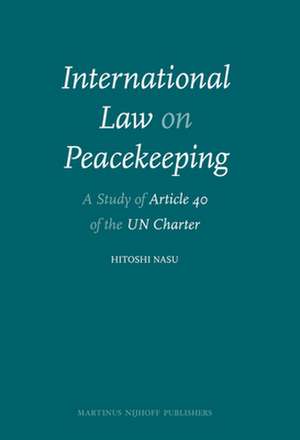International Law on Peacekeeping: A Study of Article 40 of the UN Charter
Autor Hitoshi Nasuen Limba Engleză Hardback – 25 ian 2009
This book explores the potential of the UN peacekeeping power, placing Article 40 of the UN Charter at the centre of the legal regime governing peacekeeping measures. It traces the origins of peacekeeping measures primarily in the experience of the League of Nations and identifies Article 40 of the Charter as the primary legal basis for, and the legal restraints upon, the exercise of the peacekeeping power. It examines the regulatory framework within which the United Nations, particularly the Security Council, is authorised and may even be required to direct peacekeeping measures to prevent the aggravation of armed conflicts. It suggests that the legal accountability of the Security Council in directing peacekeeping measures will be enhanced by utilising procedural mechanisms for self-regulation
Preț: 936.67 lei
Preț vechi: 1142.28 lei
-18% Nou
Puncte Express: 1405
Preț estimativ în valută:
179.24€ • 191.66$ • 149.44£
179.24€ • 191.66$ • 149.44£
Carte indisponibilă temporar
Doresc să fiu notificat când acest titlu va fi disponibil:
Se trimite...
Preluare comenzi: 021 569.72.76
Specificații
ISBN-13: 9789004172265
ISBN-10: 9004172262
Pagini: 322
Dimensiuni: 160 x 240 x 25 mm
Greutate: 0.75 kg
Editura: Brill
Colecția Brill | Nijhoff
ISBN-10: 9004172262
Pagini: 322
Dimensiuni: 160 x 240 x 25 mm
Greutate: 0.75 kg
Editura: Brill
Colecția Brill | Nijhoff
Cuprins
ACKNOWLEDGEMENTS
ABBREVIATIONS
TABLE OF CASES
TABLE OF TREATIES AND OTHER DOCUMENTS
International Treaties
Other International Documents
LIST OF UN RESOLUTIONS
Security Council Resolutions
General Assembly Resolutions
INTRODUCTION
I PEACEKEEPING IN PERSPECTIVE
1. Conflict Prevention and Peacekeeping
2. Concept of Confl ict Prevention
3. Doctrinal Paradigm of Peacekeeping
4. Legal Basis of Peacekeeping within the UN Charter
II ORIGINS OF PEACEKEEPING
1. Embryonic Rise of Peacekeeping
2. Emergence of Peacekeeping under Article 11 of the Covenant of the League of Nations
3. Emergence of Forceful Peacekeeping Measures
4. Transformation from Article 11 of the Covenant into Article 40 of the Charter
III PEACEKEEPING AS PROVISIONAL MEASURE
1. Types of Provisional Measures
2. Call for Cease-fire
3. Peace Observation
4. Peacekeeping Forces
5. Provisional Territorial Administration
6. Preventive Arms Embargo
7. Peacekeeping and Article 39 of the UN Charter
IV Legal Force and Eff ects of Peacekeeping Measures
1. Ambiguity of ‘Calls’ for Provisional Measures
2. Th e Determination of Legal Force
3. Giving Eff ects to the Legal Force
4. Legal Eff ects
5. Peacekeeping and Article 25 of the UN Charter
V IMPARTIALITY OF PEACEKEEPING MEASURES
1. Th e Principle of Non-Intervention
2. Internal Armed Confl icts and the Scope of Domestic Jurisdiction of States
3. Defi nition of Intervention and Neutrality/Impartiality
4. Peacekeeping and Article 2(7) of the UN Charter
VI ENFORCEMENT OF PEACEKEEPING MEASURES
1. Enforceability of Peacekeeping Measures
2. Conceptual Level Analysis: Peace Enforcement
3. Strategic Level Analysis: The Right of Self-Defence
4. Tactical Level Analysis: Rules of Engagement
5. Legal Constraints on the Use of Force in Peacekeeping
6. Peacekeeping and Article 42 of the UN Charter
VII REGULATORY FRAMEWORK FOR PEACEKEEPING
1. Regulation of the Peacekeeping Power
2. Jurisdictional Bases of Peacekeeping
3. Legality of Peacekeeping
4. Legitimacy of Peacekeeping
5. Peacekeeping towards the Responsibility to React and to Prevent
6. Regulatory Criteria for Peacekeeping
VIII REGULATORY CONTROL OF PEACEKEEPING
1. Political Control
2. Judicial Control
3. Self-Regulation
4. Towards Better Control of Peacekeeping
CONCLUSION
BIBLIOGRAPHY
INDEX
ABBREVIATIONS
TABLE OF CASES
TABLE OF TREATIES AND OTHER DOCUMENTS
International Treaties
Other International Documents
LIST OF UN RESOLUTIONS
Security Council Resolutions
General Assembly Resolutions
INTRODUCTION
I PEACEKEEPING IN PERSPECTIVE
1. Conflict Prevention and Peacekeeping
2. Concept of Confl ict Prevention
3. Doctrinal Paradigm of Peacekeeping
4. Legal Basis of Peacekeeping within the UN Charter
II ORIGINS OF PEACEKEEPING
1. Embryonic Rise of Peacekeeping
2. Emergence of Peacekeeping under Article 11 of the Covenant of the League of Nations
3. Emergence of Forceful Peacekeeping Measures
4. Transformation from Article 11 of the Covenant into Article 40 of the Charter
III PEACEKEEPING AS PROVISIONAL MEASURE
1. Types of Provisional Measures
2. Call for Cease-fire
3. Peace Observation
4. Peacekeeping Forces
5. Provisional Territorial Administration
6. Preventive Arms Embargo
7. Peacekeeping and Article 39 of the UN Charter
IV Legal Force and Eff ects of Peacekeeping Measures
1. Ambiguity of ‘Calls’ for Provisional Measures
2. Th e Determination of Legal Force
3. Giving Eff ects to the Legal Force
4. Legal Eff ects
5. Peacekeeping and Article 25 of the UN Charter
V IMPARTIALITY OF PEACEKEEPING MEASURES
1. Th e Principle of Non-Intervention
2. Internal Armed Confl icts and the Scope of Domestic Jurisdiction of States
3. Defi nition of Intervention and Neutrality/Impartiality
4. Peacekeeping and Article 2(7) of the UN Charter
VI ENFORCEMENT OF PEACEKEEPING MEASURES
1. Enforceability of Peacekeeping Measures
2. Conceptual Level Analysis: Peace Enforcement
3. Strategic Level Analysis: The Right of Self-Defence
4. Tactical Level Analysis: Rules of Engagement
5. Legal Constraints on the Use of Force in Peacekeeping
6. Peacekeeping and Article 42 of the UN Charter
VII REGULATORY FRAMEWORK FOR PEACEKEEPING
1. Regulation of the Peacekeeping Power
2. Jurisdictional Bases of Peacekeeping
3. Legality of Peacekeeping
4. Legitimacy of Peacekeeping
5. Peacekeeping towards the Responsibility to React and to Prevent
6. Regulatory Criteria for Peacekeeping
VIII REGULATORY CONTROL OF PEACEKEEPING
1. Political Control
2. Judicial Control
3. Self-Regulation
4. Towards Better Control of Peacekeeping
CONCLUSION
BIBLIOGRAPHY
INDEX
Notă biografică
Hitoshi Nasu is a lecturer in law at the ANU College of Law, The Australian National University. He received his Ph.D. in International Law from the Faculty of Law, The University of Sydney.
